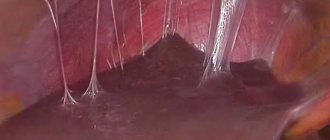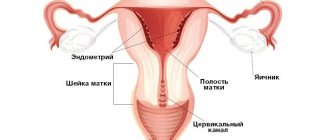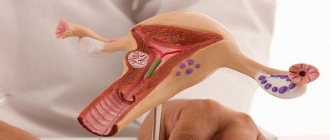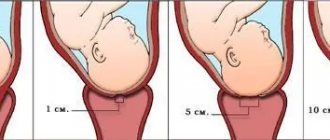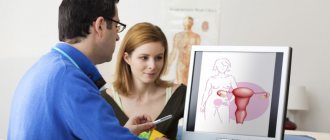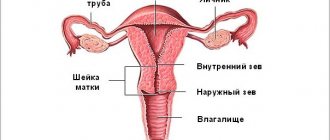The problem associated with a bent uterus is quite common today. According to the results of ongoing studies, at least 15% of women experience forward deviation of the uterus before their first birth. At the same time, a fairly large number of expectant mothers decide to use traditional treatments for uterine flexion, without turning to a specialist for help.
When considering the question of how to treat a bent uterus at home, we note that the recommended treatment at home is aimed only at maintaining the body in a healthy state. As an example, exercises to prevent the bend of the uterus at home allow you to strengthen the muscles and ligaments of the abdominal cavity, due to which the organs should be in the correct position and the bend will disappear on its own. In other words, some methods recommended by doctors allow you to correct the problem without their direct intervention, but if the cause of the bend was the development of some disease, then they cannot.
Uterus anteflexio: description, causes, symptoms, possible consequences
The uterus is located in anteflexio - what is it?
Let's find out in this article. Anteflexio is a position of the uterus in which the woman's organ bends anteriorly. The presence of a slight deviation from the norm is not a pathology at all, and at the same time does not pose any threat to women’s health. But, if the uterus is too bent towards the bladder, then problems may arise that will require correction. In this case, the body of the genital organ can deviate forward, and the neck rushes down. If the anteflexio position of the uterus is still accompanied by adhesions, intense pain may occur.
Features of eliminating pathology
Treatment of deviation of the cervix of the genital organ towards the back is carried out according to an individual plan, which is drawn up taking into account the type of pathology, the degree and mobility of the anomaly, the age of the patient and concomitant diseases in the body. Posterior tilt can be corrected using:
- prescribing anti-inflammatory therapy if there is a focus of infection in the female body;
- taking medications;
- carrying out physiotherapeutic procedures;
- the use of therapeutic physical education and gynecological massage.
It is possible to correct the pathological condition of the reproductive organ with the help of surgical intervention if there are adhesions and tumors of the pelvic organs.
Sharp corner
So, this disease is an incorrect location of the female reproductive organ. With such a disease, the angle between the body and the neck turns out to be acute, not obtuse, and it bends towards the bladder. To put it simply, the uterus in anteflexio involves the bending of a woman’s reproductive organ forward in comparison with its normal physiological position. In the presence of this pathology, the bottom of the genital organ is directed anteriorly, and the vaginal portion of the cervix is directed downward. What this is—the body of the uterus in anteflexio—is now clear. Let's look at the main causes of this disease in women.
Abnormal positions of the uterus: bend, inflection and others
Bend of the uterus is a non-standard arrangement of the organs of the female reproductive system, when the body of the uterus is deviated from its normal position.
The position of the organ changes when the bladder and rectum are full. Also, its location may shift if the muscles and ligaments of the pelvis weaken.
The position of the organ is determined in a standing woman of childbearing age after emptying the bladder and rectum. The uterus should be located in the center of the small pelvis at an equal distance from its walls, the center of the pubis and the sacrum. The organ is attached to the walls of the pelvis by a ligamentous apparatus. In a normal position, the body and cervix form an obtuse angle directed forward.
When bending, the proportions between the body and the neck change.
Often the bend is the cause of menstrual irregularities. They become painful, profuse and long-lasting.
Sometimes the bend does not show any signs, but patients may complain of pain in the lower back, which intensifies during menstruation, a feeling of pressure in the lower abdomen, difficulty urinating, and in some cases, pain during sexual intercourse.
- Anteversion is the normal position of the uterus (tilted forward).
- Retroversion - tilted posteriorly.
- Dextroversion - tilted to the right.
- Sinistroversion - tilted to the left.
- Retroflexion is a deviation backwards.
- Inflection is an inflection.
- Hypoplasia - underdevelopment of an organ, infantilism.
Bend of the uterus - causes
As a rule, this pathology occurs as a result of inflammatory processes in the internal organs of the reproductive system.
- weakness of the ligaments that fix the uterus;
- frequent constipation;
- difficult childbirth;
- abortions complicated by inflammation;
- uterine tumors (fibroids, fibroids, leiomyomas), ovarian cysts;
- inflammation of the rectum;
- endometriosis;
- adhesive process;
- feature of the constitution.
Sometimes the bend can be congenital (for example, a posterior bend - with an underdeveloped uterus).
Deflection of the uterus and pregnancy
The presence of a bend in itself is not a cause of infertility. If the bend is very pronounced, problems may arise with the seed entering the uterus. If the bend is small, then in the absence of adhesions in the fallopian tubes and ovaries, it does not interfere with conception.
Bend of the uterus: postures for conception
How to get pregnant if you have a bent uterus?
There is no need to select any special poses if the bend is insignificant. If you have a strongly curved uterus, your doctor should select positions for conception. He will determine which direction the bend is facing and, accordingly, in which positions it is easiest to get pregnant.
If there is a bend, it is usually recommended to choose positions in which the uterus and appendages move forward. For example, the knee-elbow position - the cervix moves closer to the center, as a result of which the likelihood of sperm getting into it increases.
Flexion
Flexion is the bending of the uterus. There are such forms of flexion: anteflexion - bending forward, and retroflexion - bending backward.
Anteflexion
Anteflexio is the normal position. An obtuse angle is formed between the body and the cervix, open anteriorly.
In pathological cases - anteflexio - when the angle between the body and the neck becomes acute, a bend is observed.
Retroflexion of the uterus
Retroflexion is a posterior bending of the uterus, in which the angle between the body and the cervix is directed backward. With this type of flexion, the body of the organ is tilted back, and the neck is directed anteriorly. The uterus puts pressure on the ligaments, they gradually relax, and the organ descends; If you do not consult a doctor about this problem in time, uterine prolapse may occur.
If such a bend is not very pronounced, it does not affect the process of conception.
Retroflexion can develop during the onset of puberty in girls as a consequence of underdevelopment of their reproductive apparatus. Heavy physical work, developmental defects during puberty, and disease of the large intestine disrupt the normal relationship of organs and cause deviation of the uterus.
Pathological retroflexion - an acute angle forms between the uterus and cervix.
Uterine displacement
The movement of the body and cervix in relation to the midline of the pelvis is the disposition of the uterus.
Depending on the direction of the displacement, the displacement is distinguished:
The main causes of the disease
In gynecology, we often encounter examples of congenital deviation of the named organ from its normal position. In this case, treatment tactics are determined taking into account the degree of inversion and concomitant disease. Acquired anteflexion of the uterus occurs as a result of an improperly performed abortion.
Provoking factors, as a rule, are:
- The presence of chronic infectious pathologies of the pelvic organs in a woman. Pathogens leading to similar consequences include ureaplasma, along with mycoplasma, chlamydia, gonorrhea, gardnerella, trichomonas, and more.
- The consequence of a difficult or complicated birth, occurring with cervical ruptures and heavy blood loss.
- Receiving injuries to the genital organs in certain accidents.
- The appearance of adhesions in the pelvic area during prolonged inflammatory processes.
- Consequence of surgery. Pathology may be a consequence of improperly performed diagnostic curettage, and, in addition, cauterization of erosion, laparoscopic surgery, etc.
- Exposure to excessive physical activity. This is especially true for those women who are interested in bodybuilding and other types of strength training.
Causes
Retroflexion is often a congenital anomaly that is caused by sexual infantilism. If this pathology is from birth, then, as a rule, it does not affect reproductive function. If an anomaly is acquired, you need to seriously take care of your health.
The curvature of the uterus can be fixed or movable. Such conditions may occur for the following reasons:
- rapid weight loss;
- inflammatory processes in the pelvic organs;
- strong physical activity;
- poor ligamentous apparatus in the small pelvis.
Women of the asthenic type are overly emotional and irritable, and it is they who most often experience the development of infantile genitalia.
Endometriosis
Endometriosis, which grows into the cervix or directly into the body of the uterus, can also provoke the bending of this organ from the front. The presence of weak tone of the ligamentous apparatus, which supports the organ in its normal position, can also contribute to the occurrence of anteflexio of the uterus. Additional causes are intestinal pathologies along with chronic inflammation of the ovaries and malignant tumors.
A slight change in the position of the uterus is not at all pathological if there are no characteristic symptoms and problems with conception. The congenital format of this disease will require treatment only in extreme cases, when a woman complains of pelvic pain and discomfort during sexual intercourse. Next, we move on to consider the clinical manifestations of this pathology.
In what position can you get pregnant when the uterus is bent?
It is worth understanding that you can have sex in any position, but before ejaculation you must take one of the following positions to make it easier for sperm to achieve their goal:
- The woman is below and the man is on top. In this, the most common classic position, the penis enters deeper and approaches the uterus as much as possible. Thereby increasing the chance of conception.
- Dog style pose . In this position, the man is behind, and the woman can choose the most comfortable position for herself: kneeling or lying on her side.
To “consolidate the result”, after sexual intercourse a woman is not recommended to get up for half an hour. It will also be useful to throw your legs up (as in a “birch tree”) and lie in this position for about 15 minutes. After which you can lower your legs and lie quietly for another 15-20 minutes.
When asked whether it is possible to get pregnant while the cervix is bent, doctors will answer positively. You can get pregnant even without surgery. However, you need to be patient and follow all the specialist’s recommendations.
Symptoms
This pathology is dangerous because in a mild form it almost does not manifest itself. Therefore, many women learn about the disease when anteflexion already begins to cause significant discomfort along with acute pain.
The symptoms of anteflexio versio of the uterus are pronounced if the pathology occurs as a result of adhesions. In such a situation, the uterus may be immobilized, and the adhesions themselves hold it in a certain position, which may be accompanied by severe pain. Typically, such a pathology is expressed in the form of the following series of symptoms:
- The appearance of disruptions in the menstrual cycle.
- The occurrence of frequent urge to urinate.
- The occurrence of acute pain in the lower abdomen during menstrual periods.
- The appearance of a feeling of discomfort against the background of intimacy, and sometimes just while walking.
- The occurrence of periodic pain in the groin area.
Diagnostics
The clinical features of this disease do not allow a woman to be diagnosed without ultrasound and colposcopy. Additionally, a smear is taken to identify concomitant infectious pathologies. Often, anteflexion of the uterus is recognized during a gynecological examination.
If the doctor is in doubt, he immediately sends the patient to undergo an ultrasound examination, which allows not only to detect pathology, but also to determine the degree of uterine bending with possible consequences.
A slight deviation from the norm may not be determined by a gynecologist through a standard examination. However, the presence of pathological processes is always indicated by a number of symptoms that help in making a diagnosis. We are talking about disruptions in the menstrual cycle, pain in the lower abdomen that intensifies during menstruation, and, in addition, in the presence of this disease, infertility is characteristic. Often, in addition to an ultrasound examination, the doctor finds adhesions along with endometriotic lesions and other provoking factors of the pathological process.
Possible consequences
What does anteflexio position of the uterus mean, not everyone knows. A common consequence of anterior uterine bending is, first of all, menstrual irregularities. Menstruation may become more profuse and painful with this diagnosis. Moreover, they can begin each time at different intervals.
Incorrect location of the organ turns out to be a provoking factor in the appearance of inflammatory processes. Women may also experience an increased urge to urinate. Endometrial hyperplasia often occurs, which can provoke the appearance of malignant tumors, and, in addition, denomyosis.
Symptoms of abnormalities in the location of the uterus
The symptoms of hyperanteflexia correspond to those of the underlying disease (symptoms of infantilism, inflammatory process, etc.). Since retroflexion is not an independent disease, its clinical picture is determined by the symptoms of the disease that caused retroflexion - pain, dysfunction of neighboring organs, disruption of menstrual and secretory functions. Constitutional retroflexion is asymptomatic and is discovered accidentally during routine examinations.
[34], [35], [36]
Danger of pathology during pregnancy
In the presence of pregnancy, such a pathology is extremely dangerous due to premature birth, and at the same time spontaneous abortion in the early stages. During the birth of a child, the cervix may open insufficiently and slowly, which will provoke oxygen starvation of the fetus. Birth injuries can also occur. If there is a strong bend, often the only method of labor resolution is a cesarean section.
If anteflexio in the presence of pregnancy is accompanied by adhesions in the pelvis, then pinching of the uterus may occur, which will most likely lead to miscarriage and other dangerous consequences for the fetus and the woman. A complication of untreated bending is adenomyosis, with the development of which the lesions grow into neighboring nearby organs.
Yoga
Very often you can come across the opinion that yoga for a bent uterus can solve the problem. It is worth considering that yoga itself is quite a useful activity that allows you to keep your body in good shape. There are poses in yoga from the bend of the uterus. They were developed to strengthen the abdominal and pelvic muscles, but can still be used in this case.
Yoga can be compared to physical therapy because in order to achieve certain poses you have to use muscles that are not normally stressed. Some postures may affect the muscles associated with the uterus.
Such exercises do not always bring posture and yoga should be treated with caution. This is due to the fact that when the uterus bends, it can affect other internal organs located nearby. Too much exposure can lead to serious consequences. In addition, we should not forget that one of the main reasons for the development of such a problem is the development of fibroids. They are represented by neoplasms on the walls of the uterus, which increase its size.
That is why, before deciding to practice yoga, you should consult a specialist. If there are no contraindications, then such a hobby will allow you to constantly maintain tone and health.
Treatment
In cases where the causes of anteflexio are inflammatory and infectious processes, doctors prescribe physical therapy to women along with medications (usually anti-inflammatory drugs and antibiotics).
When the cause of anteflexion is adhesive processes, patients are offered laparoscopy. With this surgical intervention, the position of the reproductive organ is quickly and easily restored, and the risks of injury are minimal. Within ten days, women return to their usual lifestyle.
An integral component of treatment in the presence of anteflexio is special gymnastics aimed at strengthening the pelvic floor muscles. An excellent help in eliminating this problem are various exercises according to the well-known Kegel technique. Women first learn the exercises under the guidance of a qualified specialist (physiotherapist), and then perform them independently at home.
In addition, for therapeutic purposes, the doctor prescribes the use of vaginal balls along with wearing a special bandage. If there is a slight bend and difficulties with conception, it is recommended to maintain a certain position during sexual intercourse. If the uterus is in such an unusual position, the woman should lie on her back.
We looked at what anteflexio of the uterus means. Knowing the characteristics of this disease, you can make timely attempts to get rid of it or reduce its manifestations.
What does it mean
The uterus in a healthy woman is in the anteflexio and anteversio position - this means that in relation to the axis of the vagina and cervix, the uterus is located at a slight anterior inclination and forms two obtuse angles with these organs. If the anterior bend of the uterus is strongly expressed, then they speak of pathological or excessive anteflexio, but doctors often omit the term “pathological” and call this pathology anteflexio.
Anteflexio of the uterus is an abnormal position of the female reproductive organ. With such a pathology, the angle between the body and the neck becomes acute and the organ bends towards the bladder. Simply put, the uterus in anteflexion is the bending of the main female reproductive organ forward, compared to its normal physiological position.
With this pathology, the bottom of the reproductive organ is directed anteriorly, and the vaginal part of the cervix is directed downward.
Forms
Displacement of the uterus can occur along a vertical plane (up and down), around the longitudinal axis and along a horizontal plane.
Displacement of the uterus along the vertical plane includes elevation of the uterus, prolapse, prolapse and inversion of the uterus. When lifted, the uterus moves upward, its bottom is located above the plane of the entrance to the pelvis, and the vaginal part of the cervix is above the spinal plane. Pathological elevation of the uterus occurs when menstrual blood accumulates in the vagina due to atresia of the hymen or lower part of the vagina, with voluminous tumors of the vagina and rectum, with encysted inflammatory effusions in the pouch of Douglas. Lifting (elevation) of the uterus can also occur when it is fused with the anterior abdominal wall after laparotomy (caesarean section, ventrofixation).
With prolapse (descensus uteri), the uterus is located below the normal level, but the vaginal part of the cervix does not protrude from the genital slit even with straining. If the cervix protrudes beyond the genital slit, they speak of uterine prolapse (prolapsus uteri). A distinction is made between incomplete and complete uterine prolapse. In case of incomplete uterine prolapse, only the vaginal part of the cervix emerges from the vagina, and the body of the uterus is located higher, outside the genital slit. With complete prolapse of the uterus, the cervix and body of the uterus are located below the genital slit. Prolapse and prolapse of the uterus are accompanied by vaginal prolapse.
Why does it occur
The congenital pathology anteflexion is associated with the individual characteristics of intrauterine development of the fetus.
The absence of symptoms in congenital anteflexion is due to the fact that the uterus retains its natural mobility and balances as the body grows.
It’s another matter when the location of the reproductive organ in anteflexion is an acquired pathology. Such a violation may occur as a result of the following factors:
- poorly performed abortion;
- the course of chronic infectious and inflammatory processes;
- difficult and protracted labor;
- mechanical damage to the genital organs;
- consequences of surgical operations;
- adhesions;
- pathological hormonal changes in the body of a drastic nature during the removal of endocrine glands, menopause, adolescence (accompanied by changes in the structure of the ligaments);
- strenuous sports and excessive physical activity.
In order to prevent the bending of the female genital organs due to such diseases, they must be promptly identified and treated.
Symptoms of the uterus
This pathology is dangerous because in a mild form it practically does not manifest itself. Therefore, many women learn about the disease when anteflexion of the uterus causes significant discomfort and acute pain.
Symptoms of anteflexio are pronounced if the pathology arose as a result of an adhesive process. In such a situation, the uterus becomes immobilized, adhesions hold it in a certain position, which is accompanied by pain.
Typically, such a disease is expressed by the following series of symptoms:
- disruptions of the menstrual cycle;
- frequent urge to urinate;
- acute pain in the lower abdomen during menstruation;
- a feeling of discomfort during intimacy, and sometimes just when walking;
- periodic pain in the groin area.
Features of diagnosis and treatment
Typically, anteflexio is detected during a gynecological examination of the genitals. If the gynecologist doubts his preliminary diagnosis, he sends the woman for a pelvic ultrasound. Ultrasound examination allows us to reveal the full picture of the pathology. If the ultrasound results confirm that the uterus is located in anteflexion, the specialist will prescribe appropriate treatment.
In cases where the cause of anteflexio is inflammatory and infectious processes, the doctor prescribes physical therapy and medications (anti-inflammatory drugs and antibiotics) to the woman.
If the cause of anteflexion is adhesions, the patient is offered laparoscopy. With such surgical intervention, the position of the organ is restored quite quickly and easily, and the risk of injury is minimal. After 7–10 days, the woman returns to her usual way of life.
An integral component of therapy for anteflexio is special gymnastics aimed at strengthening the pelvic floor muscles. An excellent help in eliminating this problem are exercises according to the Kegel technique. A woman first learns the exercises under the guidance of a specialist (physiotherapist), and then performs them independently at home.
If there is a slight bend and difficulties with conception, it is recommended to adhere to certain positions during sexual intercourse. If the uterus is in a pathological anteflexion position, the woman should be positioned in a supine position.
Bend of the uterus: treatment and diagnosis
Diagnosis of changes in the position of the uterus occurs during a routine appointment with an obstetrician-gynecologist, even in the absence of complaints. The diagnosis is confirmed after a thorough examination, which includes:
- Collecting the patient’s medical history, paying attention to symptoms such as painful menstruation and sexual intercourse.
- Gynecological examination.
- Ultrasound examination of the pelvic organs - ultrasound, is prescribed using a special vaginal sensor.
- MRI of the pelvic organs.
- Conducting laboratory tests for the presence of infectious disease agents (STIs)
- Determination of hormonal levels.
Expert opinion
As for treatment, it is always strictly individual, should be prescribed only by the attending physician and requires strict adherence to all recommendations. It is impossible to cure a bent uterus using folk remedies. Any non-traditional methods can only be considered as an addition to the main therapy.
Obstetrician-gynecologist of the highest category Oksana Anatolyevna Gartleb
How to prevent
To prevent the risk of developing anteflexion, every woman should follow the following recommendations for the prevention of the disease:
- It is necessary to visit a gynecologist twice a year and undergo a full examination of the pelvic organs.
- Avoid physical inactivity and overeating.
- Physical activity should be moderate.
If the examination reveals infectious or inflammatory diseases of the genitourinary system, it is necessary to immediately begin their treatment in accordance with the recommendations of a specialist. It is advisable to have one reliable sexual partner to eliminate the risk of sexually transmitted diseases.
